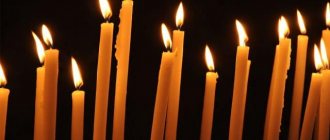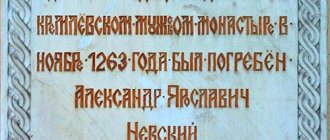In Orthodoxy, people who have given their lives to serving God are buried in a special way. The burial rite performed over them is different from the rite that is performed over ordinary parishioners of the Church. Moreover, ritual actions depend on the status of the deceased: for novices the deathly succession is one thing, and for the clergy it is another.
History of burial ranks
It is curious that the order of rites known to us today appeared relatively recently. The idea of a special order for the funeral of clergy arose in Byzantium in the 14th century. Before that, the Byzantine church had a common burial rite for all, which was most reminiscent of how Orthodox monks are buried today. So, a special order was invented in Byzantium and spread by the end of the 14th century. In the 15th century, the same order was adopted by the Russian kingdom. It is noteworthy in this story that historically it was not the priestly burial rite that arose from the complication of the “ordinary”, secular rite, but on the contrary: the funeral rite of the laity arose as a result of the simplification of the original rite, which is still applied only to clergy. In Rus', the new system of rites was spread by Metropolitan Cyprian: this was specifically expressed in the corrections that he made to the Service Book and Trebnik.
Funeral chime
When burying clergy, a special funeral bell rings, varying depending on what stage of the funeral rite is currently taking place. For example, while the funeral procession is walking to the grave, a single chime of bells sounds. When the funeral service is performed for the deceased and the Gospel is read, the number of strikes of the bell corresponds to the number of the passage from the psalm that is now being read. When the body is brought into the church and when it is lowered into the grave, the bell ringer must make a trezvon - a three-beat strong ringing of several bells at the same time.
Procession and bell ringing
It is customary for the body of a lay person to be carried out to close people, but not to relatives. But the body of the priest is necessarily carried by priests in white robes. Before the coffin of the clergyman, they carry the Holy Scriptures, banners and a cross, which makes the funeral procession look like a religious procession.
Bells are rung at funerals of both laity and priests. But if, during the burial of the laity, first an enumeration of small bells sounds, and then a large bell begins, and each circle of such enumeration ends with the simultaneous ringing of all the bells, which symbolizes the end of a person’s earthly life, then the priest’s funeral is accompanied by a different bell ringing. When reading the Gospel during the funeral service, the bell is struck as many times as the Gospel has been read. When the coffin is brought into the temple, as well as after the prayer of permission and burial, a peal is sounded.
Completion of readings and songs
At the final stage of the ceremony, the clergy sing stichera - hymnographic chants that are timed to coincide with a specific church event or holiday. The texts of the stichera on the stichera are divided into eight parts, which are called voices, and each voice consists of psalms. The reading of each passage from the voice must be preceded by the reading of a specific verse. At a priest's funeral, three passages from each voice are read. Finally, a prayer of permission is read. At the end of her reading, the scroll with her text is rolled up and placed in the hand of the deceased.
Funeral procession
When a deceased person with church rank is carried to the cathedral (parish) and to the burial place, a cross, banners and Holy Scripture are carried in front of the column. The ringing of the funeral bell is heard during the cortege, as it symbolizes the procession of the cross. In every church, as the funeral procession approaches, the bells begin to ring.
All traffic stops near the temple for the funeral litany and the reading of “Helper and Patron” (introductory verses of the canon). In the temple, candlesticks with candles are placed on each side of the coffin. Only clergy can carry the body of a deceased priest.
Seeing off the deceased
When the body of a priest is carried to the church or from the church to the cemetery, someone must carry the Holy Scriptures, a cross and banners in front of his coffin. This procession is considered a religious procession, so it must be accompanied by the funeral bell ringing. Any temple that a funeral procession passes must ring its bells. In this case, the procession must stop in front of this temple and perform a funeral lithium. When transporting the deceased, litiya sounds, as well as verses of the canon “Helper and Patron”. When the coffin is in the temple, there should be four candlesticks on four sides of it. It is important that the body or coffin containing the body of a dead clergyman should only be carried by other clergymen.
Final readings of prayers
At the end of the funeral ceremony for the priest, stichera are read - hymnographic chants pronounced on special occasions. All stichera are divided into 8 parts or voices. Each voice contains three passages from the corresponding psalms. So, before pronouncing the first, Psalm 142:8 is read:
“Bring my soul out of prison, to confess to Your Name.”
At the end of the prayers, a prayer of permission is read from the scroll, which is then rolled up and placed in the hand of the deceased.
Ritual order
The burial of a priest begins in the house in the same way as the laity, with a lithium; but in this case there is no discharge at the litiya: it is connected with the subsequent burial.
Blessed be our God,
the trisagion
is sung and then the opening prayers are read.
After the cry of Our Father,
the troparia of the lithium are sung
from the spirits of the righteous who have died...
And there is a funeral litany, after which the priests take the deceased and carry him to the temple.
In the temple they sing immediately blameless
for 3 articles, followed by the troparion
of the Peace of the Savior,
as at the burial of the laity.
The troparions of the immaculate
are not sung, but after the deceased troparion the sedate stichera are immediately read
,
and then
the Apostles
and
the Gospels.
The leading priest reads the 1st Gospel, then reads the 1st prayer: the following Gospels
and the prayers are read by other priests in order
(Handbook for studying the Theology of the Orthodox Church. Nikolsk. 749 pp.).
Funeral service for a clergyman
Before the funeral of a priest, there are five readings from the Apostle, followed in turn by five readings from the Gospel. Special prayers for repose follow the first, second and third readings of the Gospels. After the fourth reading of the Gospel, troparia on “Blessed” are sung. Following the fifth reading of the Gospel comes the 50th Psalm: “God have mercy on me...”
After the sixth song of the canon, following the kontakion: “Rest with the saints...”, 24 ikos are read, each of which ends with the singing: “Hallelujah.” When the doxology ends, three stichera are sung for each of the eight voices: “What is the sweetness of life...”. Then the prayer of permission is read, and its scrolled text is placed in the hand of the deceased.
Washing and vesting
The dead layman is usually washed by relatives or specially invited persons. Only clergy are entrusted with preparing the body of a priest for a meeting with the Lord. The three of them wipe the body of the deceased with damp sponges, making cross-shaped movements.
Like a layman, a priest is dressed in exclusively new clothes - shirt, trousers, boots. But then the secular clothing is covered with the vestments of a clergyman, corresponding to the ecclesiastical status of the deceased. If a priest was forbidden to serve during his lifetime for some reason, he can be dressed in liturgical vestments only with the permission of the bishop.
A cross is placed in the hands of the deceased priest, symbolizing the salvation of the living and the dead, as well as the Gospel as a sign that the person proclaimed to people about the life of the Lord and the coming of the Kingdom of God.
Covering the face with air
The face of one who has given himself to serving the Lord is “covered with air” at the funeral. This is the symbolic name for a liturgical cloth placed on the face of a deceased clergyman or a cover, a special piece of fabric used for the same purposes when burying monks. There are two explanations for this custom:
Question and answer
Where are dead clergymen buried?
In a plot allocated next to the church of which the deceased was a member of the clergy. If this is not possible, burial is carried out on the territory of a regular city or rural cemetery.
Are there churches in Minsk with plots where clergy are buried?
Yes, such graves can be found, for example, at the Military Cemetery on the street. Kozlova.
Can a priest be buried according to secular tradition?
This only happens if the deceased was removed from the affairs of the church. However, with the permission of the bishop, even under such circumstances, burial reserved for the clergy is permitted.
Reading liturgical scriptures
Step-by-step order of reading liturgical texts (canon, prayers)
- At the stage of ablution.
- After the deceased is dressed in a cassock.
- Before the funeral procession begins.
The burial is always accompanied by a special bell ringing, which changes during various processes of the funeral ritual. When the column with the body moves to the cemetery (tomb), a continuous bell chime is heard. At the beginning of the funeral service, fragments from the Gospel are read, the alarm is sounded, observing the number of the read fragment of the troparion. When the deceased is brought into the cathedral, a prayer service is read.
At the final stage of the ritual, the clergy perform certain songs - stichera. Chants are intended for specific events and holidays. The stichera include eight episodes, each of which is called voices. The voices are divided into parts from the psalm. Each part of the voice is preceded by a specific episode: the first part of the voice is always preceded by Psalm 142:8: “Bring out my soul from prison, confess Your name.” At the funeral, three verses from each part are read. At the end, at the end, a prayer of permission is read. After reading, a folded scroll with the text is placed in the hand of the deceased.
Liturgical plate
During the earthly life of Jesus Christ, the burial tradition included covering the face of the deceased with a special scarf. This custom continues to this day at priestly funerals. The face of the deceased is covered with air - an embroidered cloth placed on the Sacred Gifts during the service. This denotes the special involvement of the clergyman in the celebration of the Holy Mysteries of the Body and Blood of Christ. The funeral service and burial are performed with this embroidered scarf.
Organizing a funeral requires a set of actions that are carried out promptly, carefully, taking into account specific circumstances.
Funeral arrangements
The face is covered with air
The tradition of burying a Christian with a covered face began with the burial of Jesus Christ, whose face was covered by the sovereign. Sir - a handkerchief for wiping sweat from the face. This tradition, as an imitation, has survived to this day with the only difference that priests cover their faces with air (liturgical cloth) as a sign that he was the performer of the Mysteries of God, and novices, as a sign of their voluntary departure from the world, cover their faces with a special covering ( St. K. Nikolsky. Educational regulations for divine services. Volume III, p. 154.). These traditions are indicated in the Great Breviary of Peter Mogila. There is another explanation for why priests are buried with their faces covered: at these moments it is turned to the Almighty, and therefore hidden from people.
When liturgical texts are read
Readings of prayers, canons and singing occur in the following order:
- during ablution;
- immediately after vesting;
- before the start of the funeral procession;
- when carrying the coffin out of the temple.
For the deceased Orthodox layman, “Lord have mercy”, “The Trisagion” are sung and the canon “Following the departure of the soul from the body” is read. When burying an Orthodox priest, a different canon is provided.
Preparing the body for burial
Currently, clergy are prepared for repose in the following way. First, their bodies are washed and dressed. This is done in a specific way: first, with the help of a damp sponge, three clergy rub the deceased with cross-shaped movements, and then his body is wrapped in linen. After this, the body of the clergyman should be smeared with oil using a sponge and dressed in his liturgical attire. The deceased is placed in a coffin, his face is covered with a special scarf (the so-called “air”), a cross is placed in his right hand, and the Gospel is placed in his left hand.
The tradition of covering the face at funerals itself dates back to the time of Christ himself: his face was covered with a sudar - a special scarf used to wipe away sweat from his face. There is a version according to which the faces of the clergy are covered during burial because their gaze at this moment should be turned to the Lord and not to the world, but this is most likely a later rationalization of a long-standing imitative custom. And this custom, slightly modified, has reached the present day: the difference is that today the faces of priests are covered with a liturgical cloth (because they were performers of the Mysteries of God), and a special covering is placed on the faces of novices - all these details were already set out in the Breviary of Peter the Mohyla .
As most Orthodox believers know, at the funerals of the laity, holy hymns are sung, in particular “Lord have mercy”, “Trisagion”, and the canon “Following the departure of the soul from the body” is also read. When an Orthodox priest is buried, slightly different liturgical texts are read and in a different order. Including them, there are simply more to read. In particular, prayers and canons are sung when the clergyman’s body is washed, then after he is dressed in his liturgical attire, then before the start of the funeral procession, and then again when the coffin is taken out of the church.
Washing the deceased
Washing the deceased
It is worth washing immediately after death, but only during daylight hours.
The ablution of the deceased occurs immediately after death, while his body is still warm. However, do not forget that the deceased can only be washed during the daytime.
Ablution is seen as a rite of purification, and not as an improvement in the hygiene of the deceased.
The deceased must appear before the Lord in a pure and immaculate form.
Nowadays, ablution is provided to special people involved in this, who can come to your home if necessary.
At the whim of relatives, you can refuse to conduct such services at their home, and specialists can take the body of the deceased to the morgue.
Any adult can perform ablution, except pregnant women.
Most often, the dead, regardless of gender, are washed by washers (old maids or widows), who should not be related to the deceased.
If there is no desire or opportunity to invite washers, any adult can do ablution.
Women during menstruation or pregnancy should under no circumstances wash the deceased, since deviation from this prohibition can lead to illness of the expected child.
If a child dies, he goes to heaven, according to Christian teaching, and there is no point in mourning for him.
Under no circumstances should a mother wash the body of her deceased child.
After all, in any case, she will mourn him, which is unacceptable, since this will be considered a lack of belief in the immortality of the soul.
They wash the deceased with clean water, then wipe with a towel.
So how does one wash the body? First, all clothes are removed from the deceased, after which the body is washed with warm water. Ablution begins with the face using cross-shaped movements and washes the body three times with a sponge or soft rag.
Next, the body is washed with clean water and wiped dry with a towel. Then they wash the head, after which the deceased is combed.
The things left over after ablution of the deceased are burned
When washing, the Trisagion and “Lord, have mercy” are read. According to tradition, things that were on a person at the moment of death and all items used during ablution must be burned.
The ashes and ash left after burning things are buried. Washing is a godly act and is conducive to the forgiveness of sins.
“They walked to the coffin all night.” Priest Dmitry Smirnov was buried behind the altar in his native church
Father Dmitry was buried here. Right behind the altar of his native temple.
Photo: Roman GOLOVANOV
The Cathedral of Christ the Savior did not close its doors all night from Thursday to Friday. Here stood the coffin with the body of the deceased priest Dmitry Smirnov. He passed away this Wednesday at the age of 69 years. After the coronavirus, Dmitry’s father’s chronic illnesses worsened. During the last months of his life, Father could not walk and moved in a wheelchair.
At the tomb of Dmitry Smirnov
Photo: Vladimir VELENGURIN
In the coffin, the body of Father Dmitry is dressed in white vestments. Such a Christian tradition. Death is not a grief, but a holiday. Because the deceased will meet the Savior. The Kingdom of Heaven and eternal life await him.
Father Dmitry's face is covered with a white cloth. Another of our Orthodox traditions is at the funerals of priests and monks. Where did this come from? When Christ lay in the tomb, his body was not only wrapped in a shroud, but the sir was lying on his face. This is a handkerchief for wiping away sweat. According to another version, it is believed that the priest stands before God at these moments, and his face is turned to the Lord, which is why it is closed from people.
Funeral of priest Dmitry Smirnov
Photo: Roman GOLOVANOV
All night the Psalter and Gospel were read over Father Dmitry. And people kept walking and walking. And at two, and at three, and at four o'clock. An endless queue to the priest's coffin. It didn't end until Friday morning.
People go to pay their last respects to the priest.
Photo: Vladimir VELENGURIN
The temple is full of people.
Photo: Vladimir VELENGURIN
And already early in the morning a whole crowd gathered here. Many took time off from work at their own expense and came to KhHS for the funeral service for Father Dmitry.
“He spoke these harsh words, sometimes rude, out of pain in his heart, out of love,” Bishop Panteleimon (Shatov) said, wiping away tears after the farewell ceremony. — Pope Francesco was lucky that Father Dmitry died before he heard what he said about same-sex marriage. Otherwise the Pope would have been in trouble.
Father Dmitry Smirnov was buried. Kingdom of Heaven! Everlasting memory.
Photo: Roman GOLOVANOV
The bishop remembered that Father Dmitry was not afraid of anyone with his heroic strength.
“He saved my life once.” I was waiting for the train, a drunk accosted me, and Father Dmitry defended me,” said Bishop Panteleimon. - His Christianity was not light, but genuine. I was afraid of him during my life. One could expect anything from him at any second. Now he, like a sleeping lion, lies in a coffin. And I would like to ask him... If he finds boldness before God, and he always had enough boldness, he asked that we be faithful to this truth and not be afraid of anything.
Funeral service in the temple
Photo: Vladimir VELENGURIN
From the Cathedral of Christ the Savior, the coffin with the body of Father Dmitry was taken to the Church of the Annunciation of the Blessed Virgin Mary. This is the native temple for Father Dmitry. Here he was the rector.
The coffin was carried out of the bus to the sound of bells. Then they carried it in a religious procession around the temple. And again there was an endless line of people saying goodbye - Father Dmitry’s flock. Actor Ivan Okhlobystin and journalist Arkady Mamontov stand modestly in the crowd.
In the temple at farewell
Photo: Vladimir VELENGURIN
“I went to Father Dmitry when I was still a Muslim,” one of the women tells me. “Father tells me: “Don’t talk to me about it. When will you be baptized? I gasped and answered: “With you - even tomorrow.” And she was baptized by him. The priest had the power to push people towards God.
Those who came to say goodbye to the priest
Photo: Vladimir VELENGURIN
Father Dmitry was buried on the territory of the temple. Right behind the altar. This is also an ancient tradition - to bury priests near their home churches. Well, if space allows. So that he always remains with his parish. Until the resurrection.
On the steps of the temple.
Photo: Vladimir VELENGURIN
Now you can come to Father Dmitry at any time. Share your grief. Cry about problems. Come to him as if he were alive. After all, as Father Dmitry said, there is no death.







